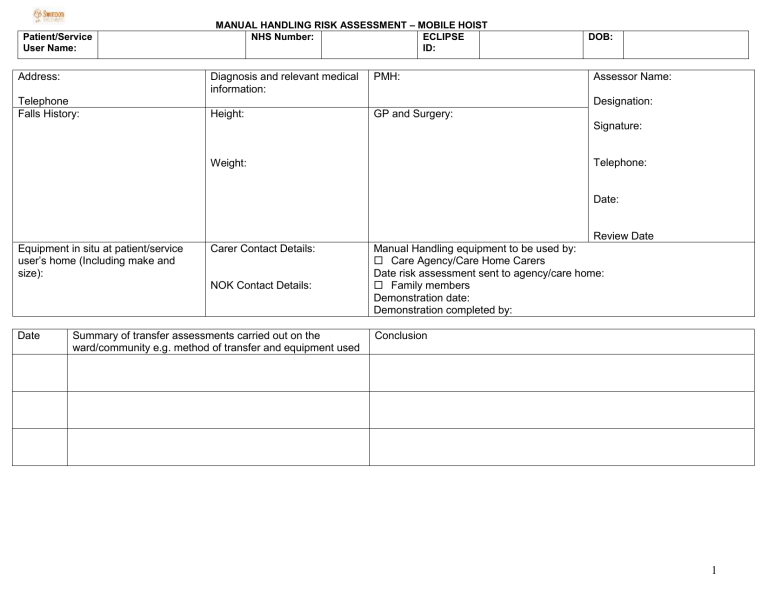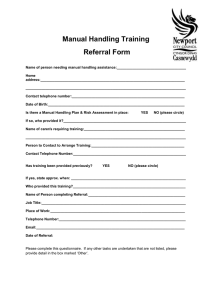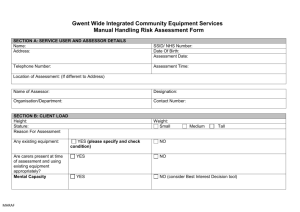
Patient/Service User Name: Address: Telephone Falls History: MANUAL HANDLING RISK ASSESSMENT – MOBILE HOIST NHS Number: ECLIPSE ID: Diagnosis and relevant medical information: PMH: Height: GP and Surgery: DOB: Assessor Name: Designation: Signature: Telephone: Weight: Date: Review Date Equipment in situ at patient/service user’s home (Including make and size): Carer Contact Details: NOK Contact Details: Date Summary of transfer assessments carried out on the ward/community e.g. method of transfer and equipment used Manual Handling equipment to be used by: Care Agency/Care Home Carers Date risk assessment sent to agency/care home: Family members Demonstration date: Demonstration completed by: Conclusion 1 MANUAL HANDLING RISK ASSESSMENT – MOBILE HOIST NHS Number: ECLIPSE ID: Patient/Service User Name: Task: DOB: Comments: Strenuous pushing or pulling? Twisting/Stooping/Reaching? Sudden or unpredictable movement? Insufficient rest or recovery? Individual: Skill Level? Specific health considerations inclusive of physical and/or cognitive capabilities? Family and/or carer preferences? Load: Weight? Sitting balance? Involuntary/unpredictable movement of patient? History of falls? Pain/Stiffness? Communication? Understanding? Agitated/Challenging Behaviour? Pressure care needs? Continence (frequency, pads, catheter) Environment: Environmental Considerations? Inadequate lighting? Space/access difficulties? Inappropriate flooring? Tripping/slipping hazards? Any other considerations: 2 Patient/Service User Name: MANUAL HANDLING RISK ASSESSMENT – MOBILE HOIST NHS Number: ECLIPSE ID: DOB: Action to be taken to reduce any identified risks Task Individual Load Environment General Safety Guidelines: 1. The Mobile Hoist should only be used in accordance with the instructions below for the named individual. 2. Always refer to the Manufacturer’s instructions. 3. Carers must have up to date moving and handling training. 4. The weight of the person being lifted must not exceed the safe working load indicated on the Mobile Hoist 5. Do not move Mrs X from room to room whilst in the Mobile Hoist. 6. Ensure wheelchair/wheeled commode/hospital bed brakes are on prior to transfer. 7. Do not apply hoist brakes at any time during transfer. 8. Ensure that battery from hoist is placed on charge when not in use. 9. Carers to check labels on the hoist to make sure it has been serviced within the previous 6 months. If not please inform the equipment company. 10. Carers to monitor slings for any signs of fraying or damage with each use. 11. Carers to adjust furniture appropriately and adopt correct posture at all times and avoid bending, twisting and stooping movements. 12. Particular care should be taken to avoid sheering and friction of Mrs X’s skin 13. Carers should not attempt tasks that are beyond their own or Mrs X’s capability. If in doubt, contact senior staff. 3 Patient/Service User Name: Transfer: R11. Bed to wheelchair/wheel ed commode and back MANUAL HANDLING RISK ASSESSMENT – MOBILE HOIST NHS Number: ECLIPSE ID: Equipment for No. of transfer: carers Mobile electric hoist: (enter 2 brand) Sling: (enter type and size) Slide Sheet: (enter type and size) Hospital bed: (enter mattress type, if bed safety rails etc) Wheeled commode/wheelchair Techniques recommended: 2. Sitting to sitting i.e. Wheeled commode to chair and back. Mobile electric hoist: (enter brand) Sling: (enter type and size) Chair/wheeled commode/wheelchair 2 DOB: Position wheelchair/commode next to bed. Carers to position hospital bed at appropriate height in order to safely assist with manual handling care tasks (appropriate height for shortest carer) Fit sling as per training and manufacturer’s instructions using slide sheet if needed Position spreader bar so is directly over Mrs X, lower slowly to allow sling to be attached to it. Do not apply hoist brakes at any time during the transfer. If being hoisted from the bed, bring up the back of the bed to ensure a more comfortable position for Mrs X to be hoisted from i.e. in sitting rather than lying Fit sling onto spreader bar using the loops identified by OT (enter as appropriate) Use hoist control and proceed with the lift When Mrs X is slightly lifted off the bed/wheelchair/wheeled commode, carers to check sling and loops are fitted correctly and that Mrs X is comfortable before fully lifting, if not lower and refit sling as above Position Mrs X over bed/wheelchair/wheeled commode o Either, lower gently into position, ensuring Mrs X is sitting with their bottom touching the back of the wheelchair/wheeled commode or; o Lower gently into position, ensuring Mrs X is sitting comfortably in bed with the back rest raised Detach loop from spreader bar and remove sling as per manufacturer’s instructions. Position wheelchair/wheeled commode next wheelchair/wheeled commode/chair Fit sling as per training and manufacturer’s instructions using slide sheet if needed Position spreader bar so is directly over Mrs X, lower slowly to allow sling to be attached to it. Fit sling onto spreader bar using the loops identified by OT (enter as appropriate) Use hoist control and proceed with the lift When Mrs X is slightly lifted off the wheelchair/wheeled commode/chair, carers to check sling and loops are fitted correctly and that Mrs X is comfortable before fully lifting, if not lower and refit sling as above Position Mrs X over wheelchair/wheeled commode/chair Lower gently into position, ensure Mrs X is sitting with their bottom touching the back of the wheelchair/wheeled commode/chair Detach loop from spreader bar and remove sling as per manufacturer’s instructions. 4

